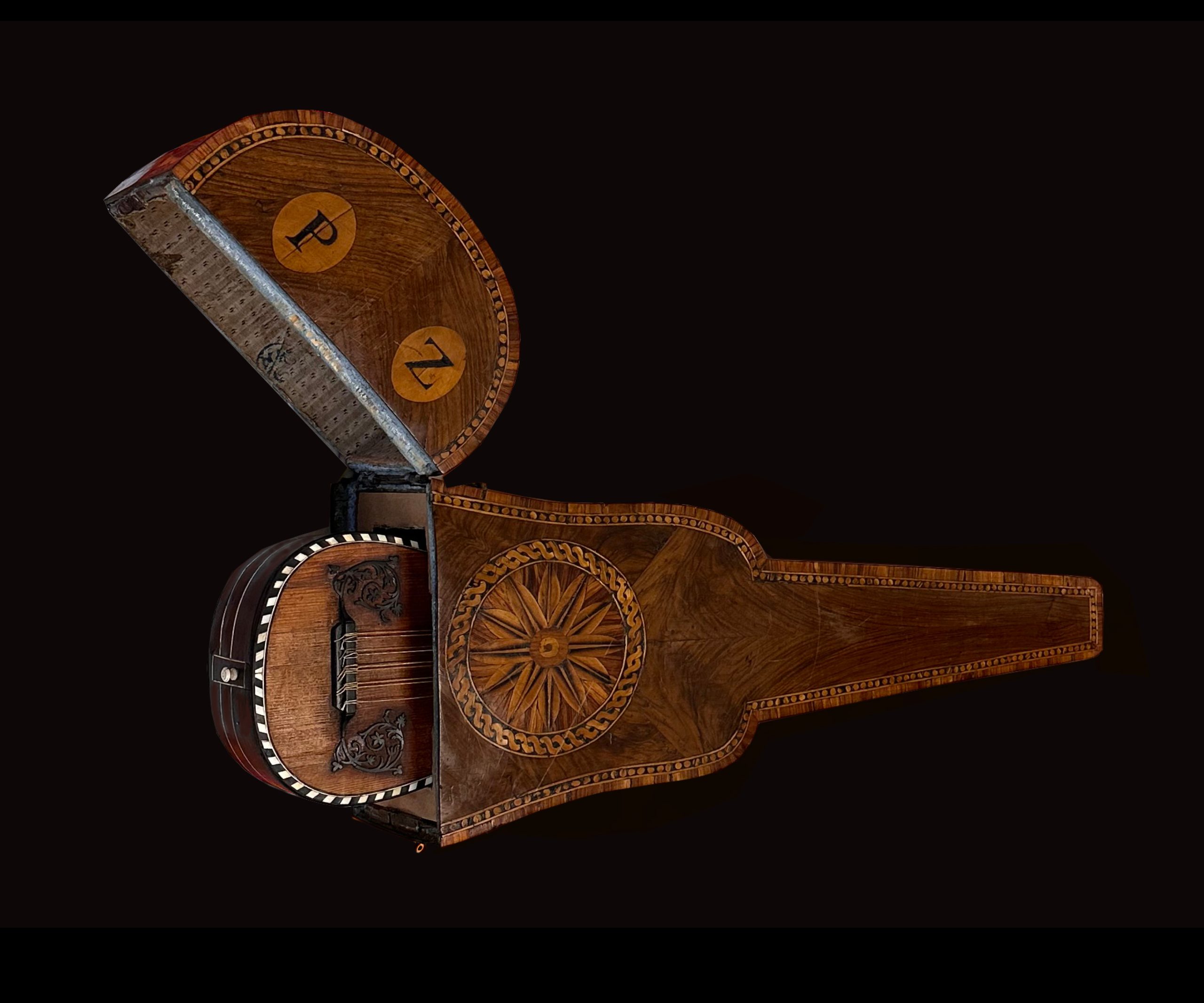The diminutive c. 1640 five-course guitar in the Austin-Marie Collection is a descendant of the four-course guitar popularized during the Renaissance. (Courses are generally paired strings positioned in close proximity, similar to a modern 12-string guitar.) A fifth course was added to the guitar in the mid-sixteenth century, and by the dawn of the Baroque era, a configuration of five courses became the standard arrangement for the next century and a half.
| Specifications | |
| Date | c. 1640 |
| Location | France |
| Length of Guitar | 720mm |
| String Length | 508mm |
| Upper Bout Width | 143mm |
| Waist Width | 130mm |
| Lower Bout Width | 185mm |
| Side Depth at Waist | 68mm |
| Soundboard: Spruce | Back: Vaulted fruitwood | Sides: Ebony with ivory fillets| Details: Carved ebony bridge mustache | |


Juan Carlos Amat’s Guitarra Española de cinco ordines, first published in 1596, is one of the earliest known treatises that provided instruction on how to string and play the five-course guitar. His work included defining the intervals between the courses: 4th, 4th, major 3rd, & 4th (similar to the top five strings of a modern guitar). Amat recommended the highest string be a single (often referred to as a chanterelle), courses two and three be tuned in unison, and the bottom two courses be tuned in octaves (the lower of the two strings called a bourdon.) Amat’s work focused exclusively on strumming the guitar for vocal accompaniment.
Amat’s use of bourdons on the fourth and fifth courses was far from the standard practice, however, as many notable guitarists including Sanz, Corbetta, Foscarini, and de Visée, sometimes recommended “re-entrant” tuning (or variations thereof) that would have four – or all five – courses tuned in unison with the fourth course pitched higher than courses 2, 3, & 5, and the fifth course pitched higher than the third course. In some instances, guitarists suggested using both bourdons and re-entrant depending on the circumstances (e.g. vocal accompaniment versus solo work). Re-entrant tuning produced a campanella (bell-like) sonority that was quite effective in solo performance.
We can conclude from surviving method books and manuscripts that seventeenth century guitarists were generally more flexible in their tuning practices and did not widely adhere to a standardized tuning convention as seen with the later six-string guitar.
Often mislabeled a “child’s guitar,” even in contemporary auction catalogues, the chitarriglia (small guitar) in this collection was tuned a fourth higher than the standard seventeenth-century guitar and fulfilled the role that a violin might play in a consort with lower pitched bowed instruments. British musicologist Monica Hall writes that during the Baroque era, five-course guitars “were clearly made in different sizes” and were sometimes used for accompaniment in a consort of guitars. The smallest to the largest guitars in the consort would play the same music, reading from the same notation, but at different pitch levels. This was especially true in early ensemble works utilizing alfabeto, a simple chord labeling system that served as an alternative to tablature.
However, the alfabeto system can be confusing to a modern guitarist because the chord labels do not correspond to traditional chord designations. The alfabeto chord labeled “C” for example, is fingered as a traditional D major chord on the modern guitar and the alfabeto chord labeled “A” is fingered as a traditional G major chord. For the chitarriglia to sound in unison with the lowest pitched guitar in the ensemble, the small guitar would be tuned a fifth higher and play an alfabeto “A” chord while the lowest pitched guitar in the ensemble would play an alfabeto “C” chord. Additional guitars could be added for mid-range sonority.
Francesco Corbetta provides specific instructions in his De gli scherzi armonici (1639) on how to tune guitars in a consort relative to each other and which alfabeto chords each guitar should play. The result would be for all guitars in the ensemble to sound the same chord at a different pitch.
Corbetta writes (note: chord labels A, C, I, & N are alfabeto fingerings and do not refer to traditional chords):
To tune four guitars in concert, first tune the third course of the small guitar with the fifth course of the medium sized one, and with the fourth course of the largest so that they make a unison. Then playing the third of the other medium sized guitar with the second course of the largest will make the same. Thus, the smallest and the largest will be tuned a fifth apart, one medium size a fourth and the other a third above the largest. Then playing the chord A on the smallest, chord C on the largest, chord I on one medium sized one and Chord N on the other medium sized one will sound in concert.
The anonymous chitarriglia in this collection is considerably smaller (string length bridge to nut: 508mm) than the standard-sized seventeenth-century guitar. The body is composed of a vaulted back made of fruitwood with sides of ebony and ivory fillets. The spruce top is framed in a typical French Baroque-era alternating pattern of ebony and ivory. The sound hole is embellished with a parchment rose and the rosette features two concentric bands, one with ivory diamonds set in ebony and the other a simple ebony ring. The neck and head are veneered with ebony and the bridge is adorned with an applied ebony mustache.
Particularly rare is the guitar’s original seventeenth-century instrument case, representing an older design of accessing through a hinged tail as opposed to a hinged top. The case is adorned in beautiful marquetry and features the initials P and Z.